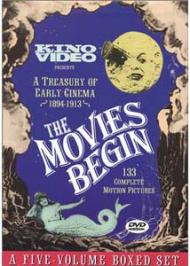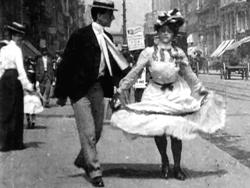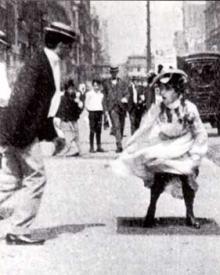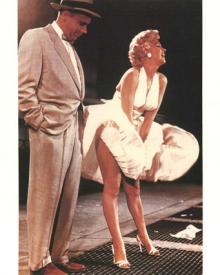Movie Review
What Happened on Twenty-third Street

US Release Date: 08-01-1901
Directed by: Edwin S. Porter
Starring▸▾
- Alfred Abadie, as
- Man
- Florence Georgie as
- Woman
![3 star[s] out of 4](http://www.threemoviebuffs.com/static/images/global/featured_gold_stars.png)

54 years before Marilyn, there was Florence Georgie.
This 1901 short, short from the Thomas Edison company is quite literally titled. It was filmed on 23rd street and 6th avenue (There's a Best Buy on that corner today) and shows a simple street scene, but with one bit of staged action acting as a sort of punchline to the film.
Apart from the man and the woman who walk toward the camera and across the grate, it's obvious that everyone else are just ordinary pedestrians. You can see many of them openly staring at the camera as they pass and some of them change direction so suddenly that you have to wonder if they were told to move out of the way by the director.
The finale of the film, when the actress's skirt is blown up (almost to her knees!), seems silly and mild today, but was quite risque for the time. Only a year after this movie was filmed and the Flatiron building was completed (also on 23rd street), legend has it that men and boys would loiter around the base of the building (where due to its unique shape, strong winds were generated) in the hopes of catching a glimpse of a young woman's shapely ankle. Police officers of the time would tell the men to, "Skiddoo", thus creating the popular phrase of the time, "23 Skiddoo".
Like so many of the movies of this period, I find them historically fascinating. It is like peering through a time machine into the past.

How daring!
There's no denying the historical importance of this movie. Although, other than the ending, it is more like what was known in those days as an “Actuality”. A filmmaker (you can’t really call them directors yet) would set up a camera and film ordinary people or things for a minute or so. They were popular in the penny arcades (where a customer put a penny into a machine and peered into a tiny window to watch the action) before they morphed into nickelodeons (which were the first actual movie theaters as we know them today).
This clip offers a fascinating glimpse of what Manhattan looked like at the turn of the 20th Century. The clothes and vehicles are fantastic. As Scott pointed, out if you have ever wondered where the archaic phrase “23 Skiddoo” came from, here’s your answer. It was used most commonly on the gridiron during college football games of the 1920s. This catchphrase was used in any number of silent comedy title cards of the day.
I wonder if Marilyn Monroe ever saw this?
![4 star[s] out of 4](http://www.threemoviebuffs.com/static/images/global/featured_gold_stars.png)

What a difference 50 years make. Marilyn Monroe and Tom Ewel in The Seven Year Itch.
I was curious about the boy in the back ground, off to the left. He stares intently toward the camera. Is he part of the project, or just an inquisitive bystander?
The Seven Year Itch was based on a play by the same name. It was written by New York born George Axelrod. His mother was silent film actress Beatrice Carpenter. It is not a stretch to imagine that Axelrod may have come across this film clip, and inspired him to copy it to his play. This tiny piece of celluloid may very well be the inspiration for one of the most iconic Hollywood movie images of the 20th century.
Photos © Copyright Thomas Edison (1901)
